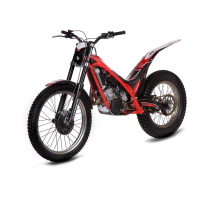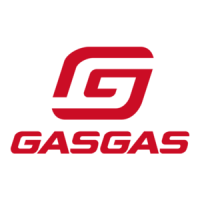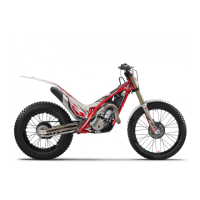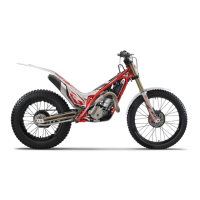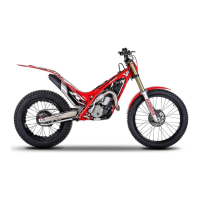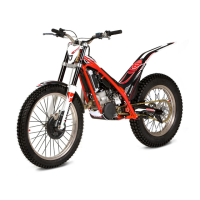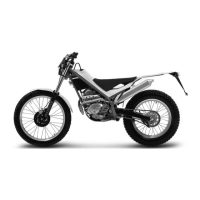
Do you have a question about the GAS GAS TX RANDONNE 2014 and is the answer not in the manual?
| Year | 2014 |
|---|---|
| Manufacturer | GAS GAS |
| Model | TX Randonne |
| Category | Motorcycle |
| Displacement | 124.8 cc |
| Cooling System | Air cooled |
| Transmission | 6-speed |
| Clutch | Wet multi-disc |
| Front Suspension | Telescopic fork |
| Rear Suspension | Monoshock |
| Front Brake | Disc |
| Rear Brake | Disc |
| Frame | Steel |
| Engine Type | Single cylinder, four-stroke |
Explains the meaning of warning symbols used in the manual for safety and damage prevention.
Defines the warranty coverage period starting from vehicle delivery and conditions for extension.
Details the process for making warranty claims and the exclusion of claims not reported within the period.
Lists conditions under which the manufacturer can reject warranty claims by the purchaser.
Specifies parts and conditions that are not covered by the warranty.
Details GG's discretion in repairs, dealer authority, and expert inspections for warranty claims.
Covers rights to contract cancellation, partial refunds, and warranty transfer upon resale.
Recommends engine running-in hours and warming up the engine before use for optimal performance.
Provides specifications for the motor (capacity, bore/stroke) and transmission (type, ratios).
Lists frame type, tyre sizes, suspension details, brake system, and overall dimensions.
Shows the electrical layout, components, and wire color codes for the 125cc model.
Shows the electrical layout, components, and wire color codes for the 200cc model.
Labels front fender, brake caliper, suspension, spark plug, filter box, and frame components.
Labels handlebar controls, seat, fuel tank, and foot pegs.
Details parts requiring check, adjustment, replacement, cleaning, and lubrication with their respective intervals.
Lists maintenance for exhaust, air filter, steering, brakes, fuel system, and suspension.
Explains the location and purpose of the serial number and homologation plate for vehicle identification.
Describes how to identify keys for ordering spares or replacements.
Details the control panel functions (lighting, turn signal, horn) and indicator switch operation.
Provides instructions on how to engage and disengage the steering lock mechanism.
States fuel tank capacity and outlines critical safety guidelines for handling gasoline.
Explains the procedure for opening and closing the quick-release fuel tank cap and checking its seal.
Explains the positions of the fuel tap for normal operation, reserve, and fuel shut-off.
Describes how to adjust engine idling speed and air mixture using specific screws.
Specifies the maximum free play for clutch and front brake levers and the correct kick-start position.
Describes the choke's purpose in aiding cold engine starting and its effect on engine temperature.
Details the steps for checking engine oil level using the dipstick and ensuring it's between max and min marks.
Specifies the engine oil capacity and the location of the oil drain cap.
Outlines the process for removing, cleaning, drying, and oiling the air filter foam.
Explains the need to periodically check the spark plug condition and how to clean it.
Specifies the correct spark plug gap range and the recommended spark plug type for the motorcycle.
Details the front fork diameter, air chamber level, and overall length.
Explains how to measure and adjust the rear damper spring preloading using a special wrench.
Emphasizes the importance of periodically checking the condition of swingarm bearings and related parts.
Advises periodic cleaning, inspection, and lubrication of the rear suspension linkage with grease.
Instructs to use special oil for lubricating pivot points of brake and clutch levers.
Details lubricating the gear shift lever pivot and the rear brake pedal bearings.
Advises applying grease to footrest springs and fixtures for smooth operation.
Recommends applying grease to the linkage of the engine starting pedal.
Stresses the importance of thoroughly cleaning and frequently lubricating the drive chain due to exposure.
Advises frequent lubrication of the chain tensioner spring due to high stress.
Recommends frequent oiling and cleaning of the throttle control, especially after high-pressure washing.
Explains using shaft excentrics to regulate chain slack and center the rear wheel.
Specifies that the master link clip must be placed opposite to the direction of wheel travel.
Emphasizes checking tyre conditions regularly to ensure optimal performance, showing good and bad examples.
States the importance of periodically checking tyre pressure and lists recommended pressures for front and rear wheels.
Advises checking front and rear brake pad wear to ensure efficient braking power.
Explains how to verify the front brake fluid level through a transparent inspection window.
Details checking the brake fluid level in the tank and ensuring the marks are parallel.
Lists steps for preparing the motorcycle for extended storage, including cleaning, lubrication, and protection.
Outlines the steps required to start the motorcycle after a period of extended storage.
Describes the features of the multifunction device, including speed, tripmeters, clock, and maintenance reminders.
Explains how to enter the setup menu by holding specific buttons for a duration.
Guides on adjusting distance units (km/miles) and setting the front tire size.
Explains how to adjust clock format, set the time, and configure the maintenance reminder method and value.
Describes the DST (Distance Traveled) and DST2 screens for tracking travel data and resetting them.
Lists possible causes for an engine not starting and provides remedies like checking fuel and spark plug.
Identifies reasons for the engine starting then stopping and suggests checks for air supply and fuel.
Addresses issues like irregular engine operation, lack of power, and abnormal noises with corresponding solutions.
Explains causes for white and brown smoke from the exhaust and suggests remedies like checking gaskets and throttle cable.
Covers causes for motorcycle instability, shock absorber settings, and abnormal noises with remedies.
Addresses issues with drive chain adjustment, lubrication, alignment, and brake operation.
Details causes and remedies for brakes not operating correctly, including fluid leaks and pad wear.
Covers causes for abnormal motorcycle noises, handlebar vibration, and the motorcycle pulling to one side.
Stresses the importance of regular maintenance and careful washing to prevent damage and ensure safety.
Recommends safe riding practices, including wearing protective gear and using common sense.
Provides legal advice regarding modifications, technical specifications, and potential errors in the manual.


